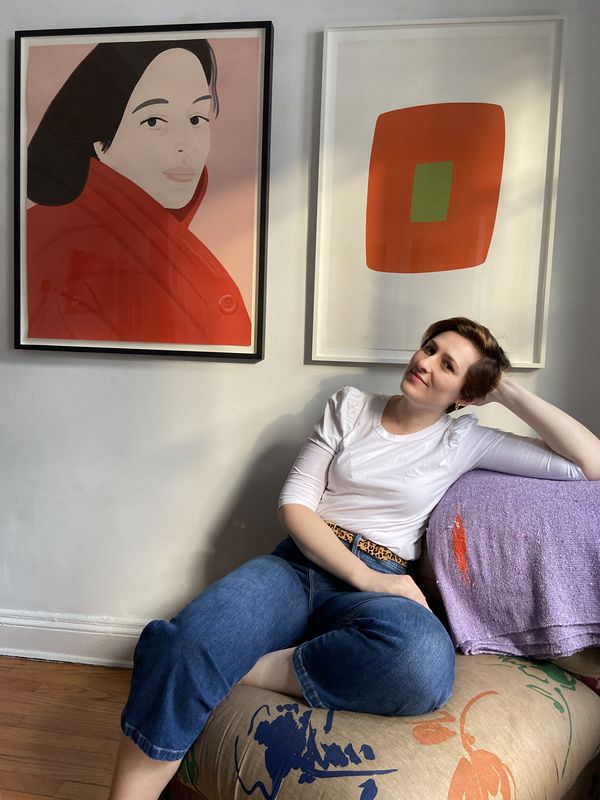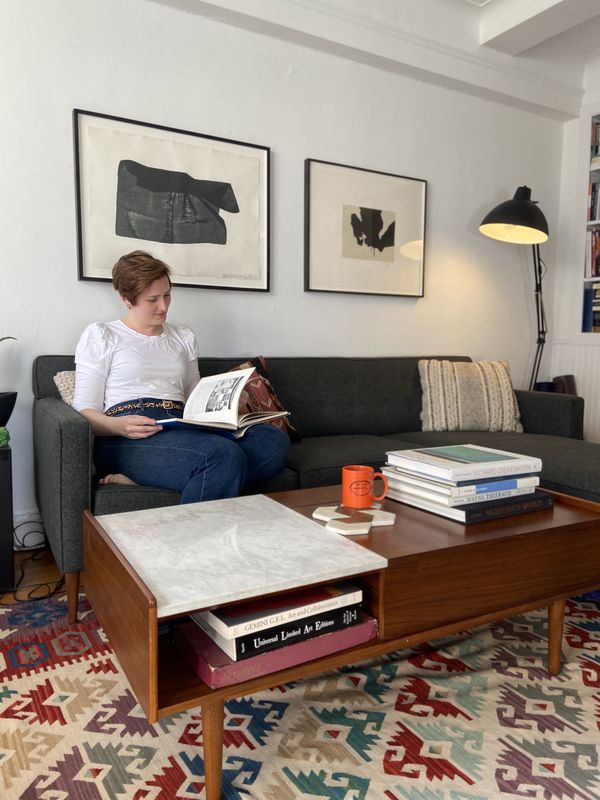Sarah Browne at home in New York, pictured with Alex Katz Brisk Day III, 1990 (left) and
Ellsworth Kelly Orange with Green, 1964 (right).
ROBERT KENNAN (Head of Editions, Europe): To put you on the spot right out the gate, why Phillips?
SARAH BROWNE (Associate Specialist, Modern and Contemporary Editions): Phillips has always been my auction house of choice. I like the overall aesthetic and presentation; I like the curation within the sales and always seem to find a new artist or artwork to add to my wish list. Before starting at Phillips, I predominately dealt with the Editions department and my experiences have always been so positive and warm. I could tell that the department really valued and respected each other, and also enjoyed working together.
Robert Kennan and Sarah Browne, in conversation.
RK: Yea, I think it is a tight crew, and it has been such an amazing experience to see where we have come to and how we have grown. Now that you work here, what have been your first impressions - sorry for the pun - and how does the auction world compare with gallery life?
SB: While working at Jim Kempner Fine Art, I dealt in the primary and secondary markets, with the majority of my secondary market focus on prints and works on paper. I enjoyed curating exhibitions and working with our artists, but I found my fascination was always with the print material and watching the auctions.
I knew by working in the Editions department at Phillips, I’d have an exceptional opportunity to work alongside colleagues with a passion for prints, who were just as excited to continuously learn about their specialty.
RK: Ok, now a print nerd question... what’s your favorite technique? Lino, riso, intaglio, Joe DiMaggio?
SB: I am always drawn to the rich, velvety surface of a carborundum etching, but truthfully, I think each process shines when aligned with a great print shop and artist.
RK: Yea, each technique does have a sort of magic to them. Which print shop or publisher’s work excites you most and why?
SB: Historically, I'd have to say Tyler Graphics. I recently watched a video of Ken Tyler and James Rosenquist printing the Welcome to the Water Planet series beginning in 1988. In this video, Tyler reflects on the lengths he would go to entice an artist and capture their work. This might include modifications to the shop, calling upon paper experts and engineers or mechanical prototypes. In the case of this series with Rosenquist, it was all of the above. Ultimately, what captivates me most about the artist and print shop relationship is the inventiveness provoked through collaboration. Great recent examples can be seen in works coming out of Durham Press and Two Palms, to just name a few.
Richard Diebenkorn Green, 1986.
RK: Prints are widely seen as the place to start collecting art. What made you focus on prints? What was the first print you bought and the one you covet most?
SB: My love affair with prints began while I was studying at Boston University, working in the print shop and learning the various print techniques firsthand. It was such a treat to then deal in works by my print heroes, like Bourgeois, Nevelson, Rauschenberg and Johns, which I previously only admired in the books in my studio.
The first print in my collection, which was partially a gift from my former boss, was Robert Rauschenberg’s Veils 3 from 1974. Rauschenberg is an artist whose work really embodies the collaborative and inventive nature of printmaking. Rauschenberg’s Veils series was created using Tatyana Grosman’s scarf. Rauschenberg dipped her scarf in tusche and etched it onto a lithography stone in four different compositions. Grosman was the founder of ULAE (Universal Limited Art Editions) and was responsible for introducing printmaking to great artists such as Larry Rivers, Jasper Johns and Robert Rauschenberg, to name a few, thus making printmaking a prominent medium in the US.
As far as work I covet, tied for first place one would be Helen Frankenthaler’s Japanese Maple woodcut from 2005 and Richard Diebenkorn's iconic intaglio Green from 1986.
Sarah Browne with Robert Rauschenberg Veils 3, 1974 (left) and Robert Motherwell Untitled, from Octavio Paz Suite, 1988 (right).
RK: Being a print collector yourself, what advice do you give to young collectors?
SB: I have often found that, in the beginning, collectors get hung up on what they should buy and whether it will hold its value. Personally, when I come across an image I like, it haunts me. I find myself thinking about it, researching it, rationalizing the cost and strategizing how to make it mine. As a result, I began buying and selling prints from my own collection fairly early on in my career. It is invigorating to actively engage in the market, and it has funded my evolving collection. Based on my experience, I can personally attest and explain to new collectors the strength within the print market and how easy it is to buy and sell. As far as what to buy, to put it simply, I say buy what resonates with you. There is nothing better than surrounding yourself with artwork that you love.



